
In Part 1 of this review, I teased Part 2 by looking forward to listening to the Super Nines with various amps. Because I had five amps in the house when I started the review, I have to admit that the listening was a lot of fun.
First, I gave the Linear Tube Audio MicroZOTL MZ3 that I recently reviewed about a five-minute listen, as I knew one watt wasn’t enough. I kept the MZ3 as the preamp, however, and hooked up Nelson Pass’ incredible little First Watt SIT-3. I know it’s only 18 watts per channel, but it is a pure class A, no negative feedback, push-pull amplifier, and the Super Nines are easy to drive and fairly efficient. The next amp I used was another Nelson Pass design, my own Pass Labs XA30.8. The other two amps used for this review were the Sugden A21SE Signature Integrated Amplifier and Parasound’s new ZM2350.
Here’s the rest of the review system:
- Preamp: Linear Tube Audio’s MicroZOTL MZ3 for the preamp with all but the Sugden, which is an integrated amp
- Vinyl Source: AMG V12 with AMG 12JT Turbo Tonearm mounted with the DS Audio DS-W2 Optical Phono Cartridge and the DS Auto Master 1 Preamp/Equalizer
- Digital System: Innuos Mini music server with a BorderPatrol DAC SE
- Cables, Cords and Power Distributor: All cables Audience Au24SX, power cords Audience Au24s, and an HB Cable Designs PowerSlave Marble Power Distributor
Initial Listening Impressions
One of the first things that I noticed about these speakers is that they are a bit more modern sounding than my Teresonic Ingenium XRs or the DeVore Orangutan speakers. By this I mean the tonal balance is more accurate and refined combined with pure beauty. That said, the detail is exceptional, and they definitely stand on the ‘juicy’ side and not the ‘dry’ side of tonal balance.
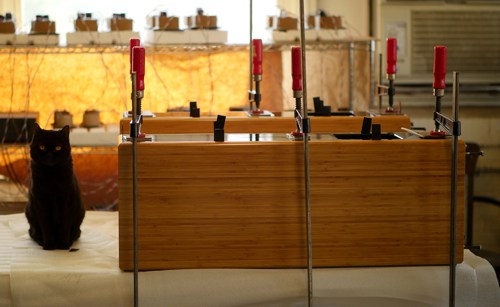
one of the DeVore Fidelity cats supervising.
If I can trust my memory, the Super Nines produced the best soundstage I have ever heard in my room. I know I often say the ability of a system to produce a soundstage isn’t that important to me, and it is way down on my list of priorities. Therefore, if I can get a sound that has plenty of tone, sounds a lot like live music and emotionally involves me in the performance, I find it very fulfilling when it also produces a great soundstage. The Super Nines do just this, and they also produce the widest and deepest soundstage I have ever heard from my system. It is also a very coherent soundstage with a real solidity to it that is in no way distracting from the music.
These speakers are also incredibly dynamic. They have the best startle factor I have heard from any speaker in my room. Although they may not startle as often as some speakers that are speed demons, when something startling came out of the pure beauty of the performance, I literally upset the table by my listening chair.
All About the Amps
The Super Nines sounded really good with all four amps, but they sounded different with each. The Pass Labs XA30.8 built the sound on a foundation of bass, mid-bass and power. This amp also had the tightest bass. The Sugden A21SE Signature was the most tube-like, and it had one of the deepest soundstages that I have ever heard.
The new Parasound ZM2350 was the biggest surprise of the bunch. It is less than half the price of the next-lowest price amp I had in house, and it pretty much held its own with them all. I will be doing a full review of this amp soon, so watch for it.
OK, so this will come as no surprise to those of you who know me. In the end, it was the First Watt SIT-3 paired with the LTA MZ3 that really made these monkeys sing.
Listening to the Super Nines
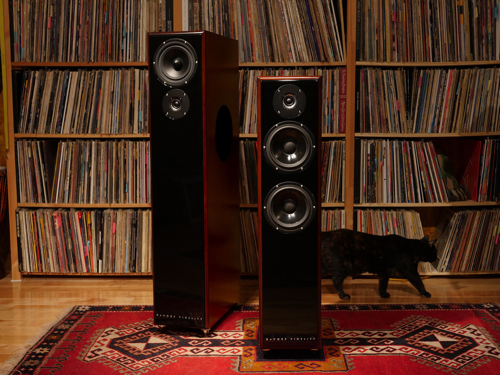
Overall the sound of this combo had an organic quality that breathed depth and life into the music. The sound was rich, layered and dimensional allowing me to hear real detail that sounded very natural and alive. I really don’t think you could listen to music on this combo without thinking it sounds beautiful.
Comparing this sound to my reference speakers used with the SIT-3, the first thing I noticed was that the Super Nines played deeper and were more extended in the top-end. The Super Nines were richer with better tone from top to bottom. Also the soundstage was considerably wider and deeper.
In addition, the Super Nines were also very dynamic and had very good micro-dynamics. The music was exceptionally energizing, life-size and powerful. They kept drawing me into performances in much the same way live music draws me in. I should add that while I was preparing to write this review, Becky and I heard both Tuck and Patty and Steve Tyrell live. Because I had just heard these artists, I had very recent reference points to compare the sound of the Super Nines to the real deal.
Drawing Conclusions
At first I thought the Super Nines fell slightly short of my Teresonic speakers and to DeVore’s own Orangutan O/96 speakers in the areas of micro-dynamics and tightness in the upper bass. However, the longer I listened to the Super Nines, I came to feel they are not only equal to these two speakers, but in several ways they are slightly better.
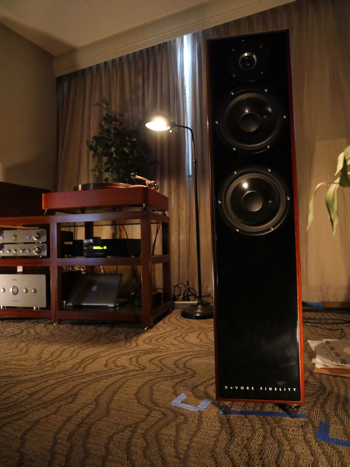
Like the DeVore Orangutan O/96 speakers, the Super Nines had the ability to transport me to a live performance in a way that few other speakers have in my room.
These speakers have plenty of power, scale, refinement and transparency. They brought music into my room and my heart and created a very soul-satisfying experience.
About the Bass
The tightness of the Super Nines’ bass was dependent on the amp. It was very tight and deep with the Pass Labs XA30.8. It was more tube-like with the Sugden. It was powerful and somewhere in between with the Parasound. But like Goldilocks’ porridge, it was just right with the First Watt SIT-3.
It was never overly tight or overly full with any of the four amps. The bass of the Super Nines created a fundamental foundation for the rest of the music to stand on. The upper-bass and lower-midrange was just tight enough to bring the rhythm of the music into the room. They allowed me to hear the wood tones of a standup bass or piano. They also produced air around and within the instruments in a way that made them occupy space and sound like real instruments. At the same time, the micro-dynamics were quick and lively enough to let the plucking of a bass or rimshots of the drum kit and especially cymbals sound startlingly alive.
Space and Dynamics
I was also impressed by how each instrument and singer seemed to occupy their own space. This was especially evident with how I could hear each backup singer on many albums. I went back and listened to Elvis and the Jordanaires like I did when I reviewed Wayne Picquet’s Restored Quad ESL 57s a few years ago.
The Super Nines were just as amazing as the Quads in how I could hear Gordon Stoker and Hoyt Hawkins in their own space. I’m not talking about their voices hanging in space, but the performers occupying space in the room. The Super Nines did this without the beaming of the Quads and with much better dynamics.
Let’s Listen to Some Tunes
Now let’s move on and talk about some specific LPs and how they sounded played through the DeVore Super Nines. Purposely, I chose the same LPs that I used when reviewing the Orangutan O/93s.
Duets – Rob Wasserman
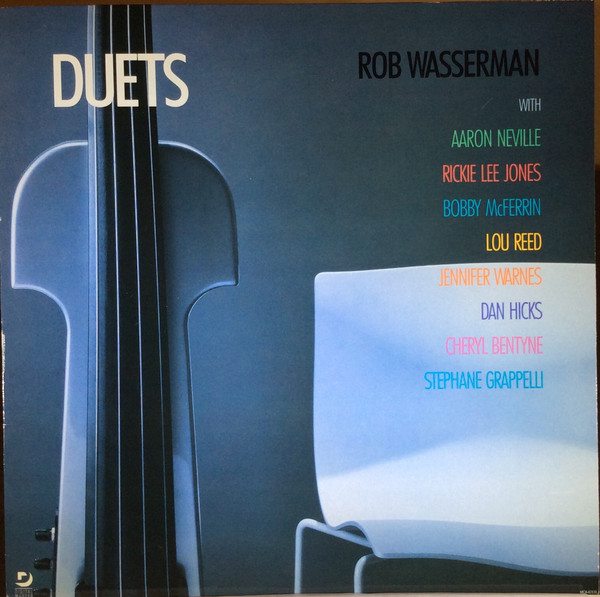
I carry this LP around at audio shows, and use it to evaluate systems. Very few systems at any price can hold it all together with the cut “Angel Eyes.” On this cut, Cheryl Bentyne’s voice goes from very soft to very loud and then back down to almost a whisper, and then it explodes to end the cut. It is a real test of a system’s dynamics, harmonics and ability to sound as good when played very softly as well as very loudly.
Over the Super Nines, Bentyne’s voice went from very low volume to extremely loud and never broke up. Wasserman’s bass sounded visceral, rich, and quick. The Super Nines played this cut as well as and better than most speakers at any price point. Her voice and the strings sounded sweeter and juicier then I hear with most speakers. Wasserman’s bass sounded simply beautiful.
Blue – Joni Mitchell
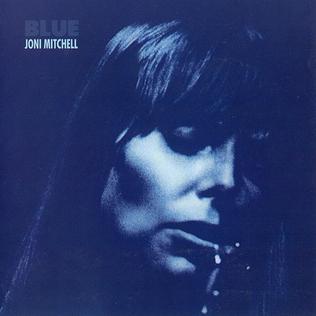
In 1971, I was a 17-year-old freshman at Baylor University and I discovered Joni Mitchell. The album, Blue, was my first exposure to her beautiful voice and her intriguing music. Well, it’s 47 years later, and I still love this album. The truth is, I probably enjoy it more now than I did when I was young and listened to it on KLH 17s, on Double Advents, and then on Quad 57s for years. The last few years it has been on my Teresonic Ingenium XR Silvers.
I know this LP inside and out. Played over the Super Nines, Mitchell’s voice sounded just right with that beautiful angelic lightness of her youth. She was placed right there in the soundstage. The piano sounded exceptional and the guitar sounded as good as I’ve ever heard. The emotions of this performance came through with great impact over the Super Nines.
The Weavers Reunion At Carnegie Hall and Belafonte Live at Carnegie HallT
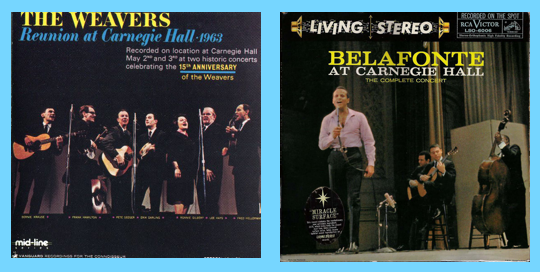
Speaking of LPs that I have listened to for many years, these are two recordings that, thanks to Harry Pearson, almost every audiophile from the early days of The Absolute Sound had to own. The Weaver’s recording was done very simply. It was recorded on three tracks with an Ampex 300 at 15 1/2 IPS. All three mics were Schoeps M-221B/26 condensers.
Both of these recordings can show the best and the worst of the way some audiophiles listen to music. So, let me say, I’m not interested in hearing tape splices, how many feet one singer is from the other or other such non-musical artifacts. These are two albums that should be real fun to listen to; they should show musical artistry that is seldom heard from folk groups or pop singers.
The listening experience of these two albums should definitely be from the perspective of you are there and not that they are in the room with you. The Super Nines are very special in that they let you hear the audiophile artifacts without keeping you from feeling as if you are in the hall enjoying a couple of incredible performances.
Sauerkraut and Solar Energy
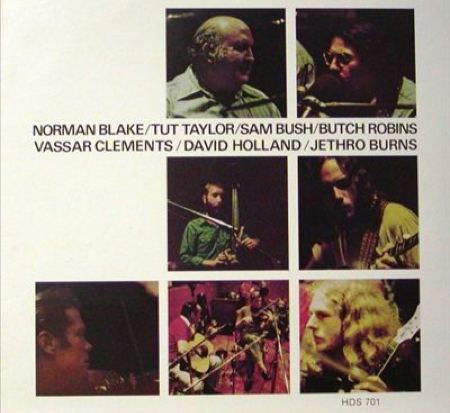
This Flying Fish album with Norman Blake, Tut Taylor, Sam Bush, Butch Robins, Vassar Clements, David Holland, and Jethro Burns is DAWG music at its best. On many modern speakers, this album is all about the leading edge andspeed. In the review of the Orangutan O/93s I said, “There should be more to this recording. Played over the O/93s there was richness and real sweetness with the strings. It portrayed the instruments nicely on the stage with air and space around and within the instruments. This recording should be loads of fun, and it was on the O/93s.”
I feared might sound too modern on the Super Nines, but I was wrong. Like the two LPs above, it did a good job of sounding both modern and still letting me experience the tone, interplay and fun of this great DAWG music.
Gershwin: Rhapsody In Blue / An American In Paris
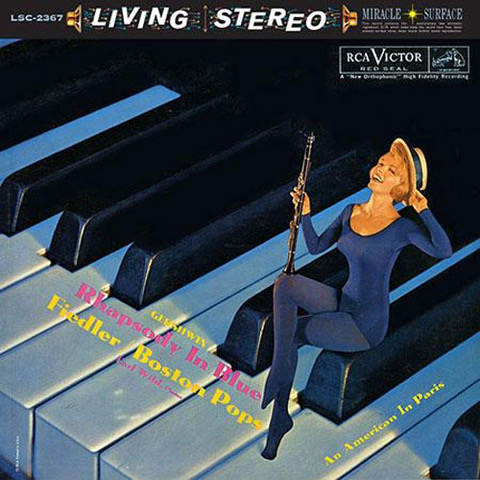
Back when I was in high school, this was one of my first ventures into what I then thought of as classical music. That mean’s, I have enjoyed this recording for over 40 years now. For these and a few other classical LPs, I preferred the Super Nines to any speaker I have heard in my room. The orchestra floated wide and deep from the front of the speakers to well behind the speakers. It was a very coherent soundstage with the instruments occupying real space. You could easily hear the hall, but it wasn’t all about the soundstage. The instruments sounded like themselves from the basses to a triangle. The violins were so sweet and airy. Overall, I had never enjoyed classical music more in my home.
It would just be wrong to talk about this album and not talk about how the piano sounded. Now you should remember, I have spent the last ten years listening to single-driver speakers as my reference. This has meant that when most speakers play piano recordings, I found the sound slightly incoherent. This has not been the case with the DeVore Orangutans or Super Nines. Pianos played over the Super Nines sounded coherent from top to bottom and with more top and bottom too. Most of all, on this recording the piano sounded simply beautiful.
Summing Up
When I heard the DeVore Fidelity Super Nines at the Rocky Mountain Audio Fest, I knew they were special. In fact, I gave them a Bongo Award for best product debut, but I never expected they were as good as they turned out to be. The Orangutan O/96 speakers were the first speakers in seven years that had tempted me to replace my reference speakers. As it turns out, I wasn’t the only reviewer to be tempted, and some of the most respected reviewers did just that, but I resisted and finally returned them to DeVore. That will not be happening with the Super Nines, and this is a shock to me.
There is something very special about this tweeter that was first used in the DeVore gibbon X. As a result, the Super Nines have slightly more sparkle, shimmer and beauty than the DeVore Orangutans or my reference speakers. I also found the bass to be more to my taste.
And, yes, I must admit that I really enjoyed their incredible soundstage. I would never buy a speaker for its soundstaging abilities, but it is surely a nice bonus coming with a speaker that has such a rich and beautiful tone.
With vocals, solo instruments, orchestras, big bands or rock groups they demonstrated startling realism that is as good or better than the DeVore Orangutans and my reference speakers. In the end, Becky and I both found the DeVore gibbon Super Nines to be speakers we want to continue to enjoy in our home.

Hi Jack,
A wonderful review, thank you for taking the time to share your thoughts with us. A couple of years agoI almost bought the O96’s based on your reviews. (I did buy the PASS 30.8′ on you recommendation.) It was a great recommendation! However, I listened to the O96’s with another member of the RMAS at the 2017 RMAF and we both came away wondering what the heck ? Piano did not sound like a piano especially in comparison to the Harbeth 30.2 .It almost seems like the John Devore voices his speakers on an old 60 – 70’s sound. Maybe thats why so many well healed “old guys” like his speakers? JUst trying to interject some humor because I am one of those old guys. Well it sounds like you were smitten with the 9″s. So in your opinion how do the two speakers differ from your old standby? HUuuummmmm next time I am in the Bay area I would love to hear the Nines.
Best wishes and much love to you and Becky,
Charlie
Hello Jack, I read with interest your selection of the DeVore gibbon Super Nines as your new speakers. I also have a First Watts SIT 3 amp which you used to drive these speakers, among other amps. I have the Omega Super Alnico Monitors with a Focal subwoofer crossover over at 40 kHz but I am looking for the next level up. I primarily listen to acoustic music. (I am also seriously looking at the microZolt preamp although you may prefer the Border Patrol preamp which is more expensive.)
When I went to check the sensitivity of the speakers I was surprised to find out that it was only 91 db. As the SIT 3 is rated at only 18 watts, I would have thought that it would not be powerful enough to drive these speakers but you apparently had no issue with it. You wrote above: But like Goldilocks’ porridge, it was just right with the First Watt SIT-3. I do not listen to my music at very loud levels. I am twenty-five miles from one of their dealers so I will have a chance to listen to them.
Hello Paul,
This is an old post, but I wonder if you ever did try the First Watt SIT-3 amp with the Devores? Lately I’ve been considering the same combo. Thanks.
Hello Jack,
thank you very much for your review. For the first time I saw the Super NInes in a dealer’s review on youtube and I immediately fell in love with them. I’m about to upgrade my system and I’m quite sure my search for a new pair of speakers has come to an end now. Fortunately, a dealer in my town is offering them and I just can’t wait to listen to them. In a German hifi magazine the reviewer also paired them up with different amps and highly recommended his Lavardin ISX Reference. Have you ever listened to Lavardin amps? And what’s your opinion about hybrid amps or pairing a tube pre-amp up with a solid state power amp? I would highly appreciate your thoughts, thanks in advance and have a happy 2024